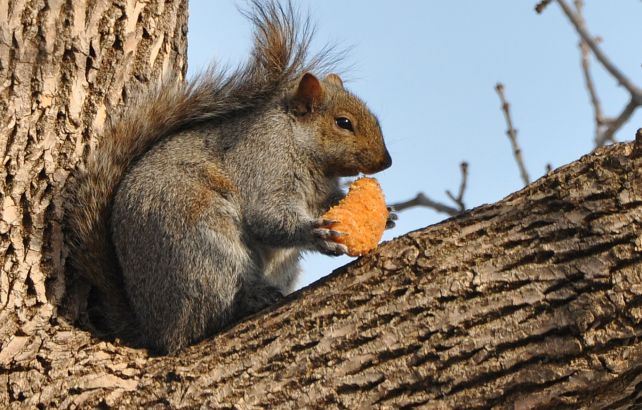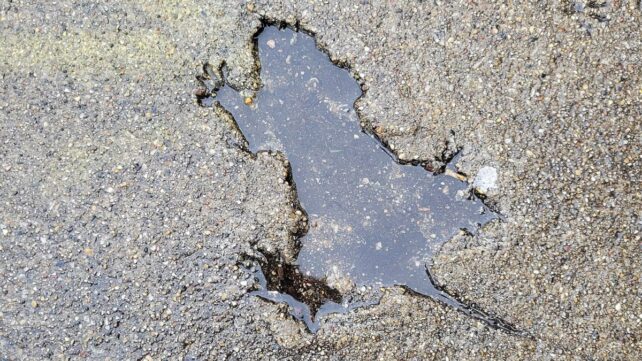The identity of the miscreant responsible for a rodent-shaped hole in a Chicago sidewalk is not the beastie everyone thought it was.
After careful examination of all the facts and evidence, a team of sleuthing scientists has determined the true identity of Splatatouille: the 'cement angel' was almost certainly excavated not by a rat (Rattus norvegicus), but by an eastern gray squirrel (Sciurus carolinensis).
"Our analyses offer little support for the hypothesis that the 'Chicago Rat Hole' was made by a brown rat. The specimen's relatively elongated forelimbs, third digits, and hindpaws exceeded the measurement ranges observed in the brown rat," the researchers write in their paper.
"Given the relative abundance of Eastern grey squirrels in the Chicago area…our data strongly suggest that the 'Chicago Rat Hole' does not reflect a murid tracemaker."
Related: This Massive Huntsman Just Ate a Lizard on a Family's Living Room Window
Pressed into wet cement decades ago, the Rat Hole appeared on the social media platform X in early January of 2024, where it rapidly skyrocketed to virality.
It didn't take long for the impression to become an urban shrine, collecting offerings of coins and at least one small baggie of estrogen pills, before it was removed by the Chicago Department of Transportation in April 2024 and taken to the City Hall-County Building, where it remains to this day.
Had to make a pilgrimage to the Chicago Rat Hole pic.twitter.com/g4P44nvJ1f
— Gatorade Should Be Thicker. (@WinslowDumaine) January 6, 2024
The shape of a rodent-like body with its hand-like paws and a long, spindly tail suggested that the impression was made by a rat that had fallen into freshly laid concrete before, presumably, skedaddling to safety.
Not everyone, however, was convinced. As early as mid-January 2024, zoologist Seth Magle of Lincoln Park Zoo suggested the impression was made by a squirrel.
Evolutionary biomechanist Michael Granatosky and his colleagues wanted to get to the bottom of the mystery.
Because the slab is currently in storage, the researchers used 25 internet-sourced photos with visible scale markers, such as coins, to measure the impression's shape and dimensions.
They compared these measurements to those of eight rodents known to frequent the Chicago area: brown rat, house mouse (Mus musculus), Eastern gray squirrel, Eastern chipmunk (Tamias striatus), muskrat (Ondatra zibethicus), white-footed mouse (Peromyscus leucopus), fox squirrel (Sciurus niger), and Southern flying squirrel (Glaucomys volans).
Each species was measured from about 50 museum specimens to avoid size bias.

These measurements included nose-to-tail length, forelimb length, third digit length, head width, and tail base width, resulting in a classification model with an accuracy of 93.5 percent. Collectively, these measurements matched two species, and neither was the brown rat.
The results suggest a 98.67 percent probability that the Rat Hole was made by either an Eastern gray squirrel or a fox squirrel, with the odds almost 50-50 between them (50.67 percent for Eastern gray and 48 percent for fox squirrel).
This squares with other evidence. Fresh pavement cement is poured during the day, when squirrels are active; rats, by contrast, are nocturnal. Moreover, there were no tracks near the impression, suggesting a direct fall – splat – into the concrete.
Squirrels tend to fall a lot, especially city squirrels; urban squirrels have 4.5 times the rate of healed fall injuries compared to rural squirrels. There was even a tree near the hole from which the squirrel could have fallen.
Even the long, spindly tail can be explained: the hair that makes up a squirrel's bushy tail is too light and flexible to press into the cement and leave an impression.
"It would actually be quite surprising if a bushy tail had been preserved… sidewalk concrete… is not an ideal medium for preserving detailed biological features like hair," the researchers explain.

But which squirrel was it? Based on the squirrel populations in the area, the researchers concluded that an Eastern gray squirrel is dramatically more likely to be hanging about. For this reason, the researchers propose that the slab be renamed the "Windy City Sidewalk Squirrel" and the viral moment be upheld as a testament to scientific curiosity.
"Even though the popular conclusion that the 'Chicago Rat Hole' was created by a brown rat is likely incorrect, the public's reasoning – based on the imprint's overall shape and the abundance of brown rats in Chicago – demonstrates an impressive use of inductive logic that the scientific community should encourage," they write in their paper.
"We hope this work – in spite of (or perhaps more specifically, because of) its inherent frivolity – resonates with both the public and the scientific community, demonstrating that scientific inquiry does not need to be confined to laboratories or burdened with impenetrable jargon.
"At its core, science simply requires curiosity and a commitment to understanding the natural world around us."
The research has been published in Biology Letters.
